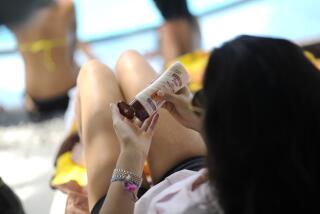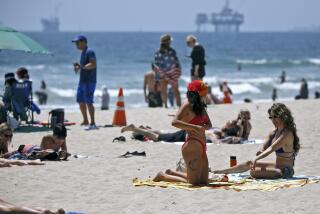HEALTHWATCH : Here’s a Ray of Hope for Avoiding Skin Exposure Problems : If you have a burning desire to enjoy the summer sun, experts say you should first learn the ABCs of UVAs, UVBs and SPFs.
- Share via
UVA, UVB, SPF.
No, these are not abbreviations for some lesser-known government agencies. Rather, as most sun worshipers can tell you, they’re important factors to consider when choosing sunscreens.
In case you haven’t noticed, sunbathing is hardly the simple pastime it once seemed to be.
Remember when it was just a matter of grabbing a swimsuit, towel and bottle of the lotion you thought would give you the deepest, darkest, tan? Sure, there was concern about sunburns, but when it came to protection, there weren’t many options.
But then along came information about sun-related skin cancer and ozone layer depletion. Consumer awareness about the dangers of sunbathing increased dramatically. And suddenly, store shelves were crammed with a variety of sunscreens with different levels of protection. Faced with such variety, consumers probably figured that one was as good as another.
End of story? Nope.
About three years ago, a sunscreen ingredient called Parsol 1789 arrived on the scene. It protects skin from UVA (Ultraviolet A) sun rays, which can cause long-term skin problems. Before that, sunscreens had concentrated on UVB rays, which are responsible for short-term sunburns.
With the slew of sunscreen products on the market, finding the right one can still be confusing. But local dermatologists say some basic knowledge will simplify things.
First, a little bit about SPFs.
The SPF, or sun protection factor, refers to the length of time one could potentially remain in the sun after applying the sunscreen. A screen with an SPF of 10 means a person safely could be exposed to the sun 10 times longer than if he or she had applied no protection.
Of course, the fairer one’s skin, the higher the sun protection factor should be.
“There are different types of skin pigmentation,” said Paul Rehder, a dermatologist with offices in Camarillo and Oxnard. “Type 1 is very fair, maybe a pale Irish person with blue-green eyes and red hair. A Type 6 person would be black, or Asian with very dark skin.”
Rehder said an SPF of 15 is enough protection even for the Type 1 person, as long the lotion is applied in adequate thickness.
Although some sunscreens have SPFs as high as 45, some dermatologists are now saying that an SPF greater than 15 is no more effective at blocking the sun than one at 15. But Dr. Ileana Zapatero said the argument misses the point.
“What’s really important, especially in Southern California, is that the sunscreen be waterproof or water-resistant,” the Westlake Village dermatologist said. “A lot of sunscreens up to SPF 15 tend not to be waterproof. If you get to SPF 30 it’s usually waterproof.”
Zapatero said people often dive into water after applying sunscreen, thus rendering it useless if it is not waterproof or water-resistant. Perspiration also may wash away protection.
So what is it that these sunscreens screen against? UVAs and UVBs.
UVB rays are responsible for sunburns. UVA rays, which penetrate more deeply, can lead to more serious skin damage. “Over time,” said Zapatero, “UVA rays can give you a higher risk of skin cancer.”
Rehder said UVA rays are present from sunup to sundown and UVB rays are most prevalent between 10 a.m. and 2 p.m.
Some words of caution: Don’t expect those predominantly overcast skies, for which Ventura County summers are famous, to save you from exposure to sun.
“Overcast is more dangerous, because it cuts down very little,” Zapatero said. “The sun is out there and it’s going right through (the clouds) and people are not feeling it because it’s cooler. We get a lot of sunburn.”
Rehder said studies show that fog and clouds block out only 10% of the rays. “People do tend to get a false sense of security when they see overcast,” he said.
More to Read
Sign up for Essential California
The most important California stories and recommendations in your inbox every morning.
You may occasionally receive promotional content from the Los Angeles Times.










